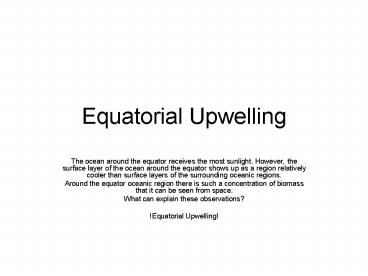Equatorial Upwelling - PowerPoint PPT Presentation
Title:
Equatorial Upwelling
Description:
Equatorial Upwelling The ocean around the equator receives the most sunlight. However, the surface layer of the ocean around the equator shows up as a region ... – PowerPoint PPT presentation
Number of Views:47
Avg rating:3.0/5.0
Title: Equatorial Upwelling
1
Equatorial Upwelling
- The ocean around the equator receives the most
sunlight. However, the surface layer of the ocean
around the equator shows up as a region
relatively cooler than surface layers of the
surrounding oceanic regions. - Around the equator oceanic region there is such a
concentration of biomass that it can be seen from
space. - What can explain these observations?
- !Equatorial Upwelling!
2
The Physics of Equatorial Upwelling
- On the earth there are trade winds that blow in
towards the equator from the northeast starting
at 30 N , and there are trade winds which blow
towards the equator from the southeast starting
at 30 S. - When these winds hit the surface of the ocean
they create an overall Ekman transport of water
perpendicular to the line of their impact. These
two trends meet at the equator, in a region
called the ITCZ (Inter-tropical convergence zone)
Southwards is the direction of transport
perpendicular to the South East trade wind, and
northwards is the direction of transport
perpendicular to the North West trade wind. - Therefore a continuous hole that must be filled
is created in the equatorial regions. The hole is
filled from below by an upwelling of cool,
nutrient rich water from the bottom of the ocean.
This overall effect is called equatorial
upwelling and it is the reason for the cooling
observed at the equator.
3
The Chemical Consequences of Equatorial Upwelling
- This transport of water up from the bottom of
ocean brings with it nutrients which sustain life
which have sunk down into the ocean. - Important nutrients brought up and recycled by
this continuous process of equatorial upwelling
include carbon, nitrogen, and phosphorus. - Therefore the surface layer of the equatorial
oceanic region of the world are especially rich
in the nutrients utilized by life, and this
region can support a greater amount of biomass.
The increase in ability to support life is so
significant the biological layer created by
equatorial upwelling can even be seen from space.
4
The Biological Consquence of Equatorial Upwelling
- The increase in nutrient availability from the
effect of equatorial upwelling leads an increased
diversity of lifeforms, and an increase in the
total biomass of lifeforms at the equator. This
increase in biomass in equatorial regions of the
ocean can even be seen from space. - Dinoflagellates and coccoid species such as
Thoracosphaera heimii may be found in regions
with equatorial upwelling. - Examples of larger organisms supported by
equatorial upwelling include sardina Pilchardus.
Equatorial upwelling allows nations such as
Morocco to have major worldwide fishing
industries. Morocco accounts for 86 of the
worlds sardina Pilchardus production and much of
the tonnage brought in by Morocco comes from its
western costal regions.
References 1. Vink, AnnemiekOn the response of
calcareous dinoflagellates to oligotropy and
stratification of the upper water column in the
Equatorial Atlantic 2. Bush, Andrew B.G. The
role of ocean-atmosphere interactions in the
tropical cooling during the last glacial
maximum 3. Benitez-Nelson Claudia R. Inorganic
and organic sinking particulate phosphorus fluxes
across the oxic/anoxic water column of Cariaco
Basin, Venezuela 4. Taoufik, Radi
Dinoflagellate Cysts as indicators of water
quality in British Columbia estuarine
environments 5. Larson, Gary A study on Crater
Lake 6. http//oceanmotion.org/html/background/up
welling-and-downwelling.htm 7. http//www.nationse
ncyclopedia.com/Africa/Morocco-FISHING.html































